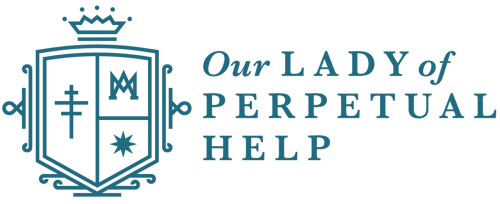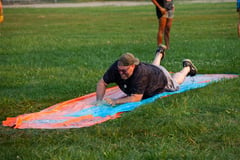Catechesis of the Good Shepherd is a Montessori-based faith formation program founded on two pillars: Sacred Scripture and Holy Liturgy. Through the use of Scripture and materials, which we call “work,” children are invited to enter into a deeper relationship with God. Over 500 of our parish’s children in both the PSR and school visit our three atria each week. For students in our school, CGS serves as a supplement to the religious education they receive in the classroom. For our parish children not enrolled in our school, CGS serves as their primary faith formation program.
During our time together, we focus on encouraging the formation of personal prayer life, helping our children to participate fully in the liturgical and sacramental life of the Church, and working to develop a deeper understanding of our Catholic identity and Tradition. Each session in the atrium is led by a certified catechist who is aided by a volunteer atrium assistant. To learn more about volunteering in the atrium, please contact our program coordinator, Julie Dilley at [email protected] or 614.875.3322, extension 326.
CGS has three levels of atria, each serving specific grade levels:
Level I: Pre-kindergarten and kindergarten
Level II: Grades 1-3
Level III: Grades 4-6
All CGS classes are offered during the school year. Our school children visit the atrium weekly as part of their school day. In addition, we offer CGS as our PSR program for our students who are homeschooled or attend a public school.
This program is so different than anything my kids have experienced before. I was very hesitant for them to participate in a program without a text book, where I really couldn’t gage what they were doing or getting. However, after three years with Mrs. Dilley I am blown away by how the faith is just a part of him! It’s not just facts he knows and can recite. He knows Jesus! That’s a gift greater than any textbook!
- Parent of a child making their First Holy Communion
Catechesis of the Good Shepherd is a method of religious formation rooted in the Bible, the liturgy of the church, and the educational principles of Maria Montessori. Children gather in an “atrium,” a room prepared for them, which contains simple, yet beautiful and often homemade materials used to lead them into the life of the church.
Many have wondered how these materials help the religious life of the child. When an adult hears a beautiful passage from the Bible, the adult might pick up a Bible, find the passage, and read it slowly again and again. He or she may think deeply about the words and perhaps speak to God in a thankful or hopeful prayer. But a little child, too young to read, needs another way. In an atrium the child can ponder a biblical passage or a prayer from the liturgy by taking the material for that text and working with it-placing wood figures of sheep in a sheepfold of the Good Shepherd, setting sculpted apostles around a Last Supper table, or preparing a small altar with the furnishings used for the Eucharist. Older children who do read often copy parables from the Bible, lay in order pre written prayers, or label a long timeline showing the history of the kingdom of God.
This catechesis was begun over 50 years ago in Rome by Sofia Cavaletti, a Catholic scholar with an expertise in Hebrew Scripture. Sofia was asked by a friend to prepare her 7-year-old son for First Communion. Knowing nothing about working with children, Sofia nevertheless began, opening the Bible to Genesis 1:1, reading bit by bit and reflecting with the boy on what they were reading. Seeing the joy, peace, and satisfaction on his face led her to imagine the awesome spiritual potentials of the child. She began a collaboration with Montessorian Gianna Gobbi, who understood the childhood development. Together with the children, these two began developing the materials you see in our atrium today. Sofia continued her work with children in her home atrium in Rome until her passing in 2011.
CGS has grown, and today children ages 3 to 12 are served in atria throughout the world, in rural Mexico, in urban Australia — from Uganda to Pakistan! At each level, the curriculum is based on what Sofia-and other catechists-discovered through careful observation over the course of many years to be the most central, absorbing, resonant work for the children.
In Level I, 3 – to 6-year-old children develop a relationship with a loving God, a God who calls his sheep by name, a God who will look for lost sheep. The children reflect upon many aspects of the Mass; the gestures and prayers they have seen so many times are named, discussed, and practiced. They learn new words, care for themselves and the environment, observe carefully, and respond with joy. The work of the 3- 6- year old child is primarily solitary work involving much repetition.
In Level II the 6- to 9-year-old children are introduced to a God who directs the unfolding of salvation history, with the aim of bringing all of creation into a deeper communion with Him. The children consider God’s work of Creation and celebrate Christ’s work of Redemption. Through the prophecies, they are offered a vision of the Parousia. A longing for harmony and the coming of the Kingdom and an end to all that is bad in the world sur faces. The children see beyond themselves, exhibiting concern for the world as a whole. In marveling at God’s gifts, they begin to take stock of their own response. They look to Jesus’ words and parables to help them to know what is right; moral formation begins. They prepare for the Sacraments. They begin to read scripture themselves. They create their own missals. They enjoy working in groups. They plan and lead prayer services.
In Level III, the 9- to 12-year-old children journal; they wrestle with moral questions as a group. Like the level II children, they plan and lead weekly prayer, which grows more complex and may echo the liturgy of the hours. Their work on salvation history becomes more detailed, as the great “Plan of God” offers them a theoretical framework for all they learn in history and science at school. They wonder what their own contribution to this history will be. Vocation is a theme they explore, through the loves of prophets and saints. Level Ill children explore the elements of the Sacraments in more detail. They examine the miracles of Jesus. They children delve into the Old Testament typology and discover parallels between the stories there and the stories they have already learned from the New Testament. They continue to strive to find harmony in their world, showing a keen interest in justice and an emerging interest in service.
In the atrium we are led by the children’s desires for relationship with God/Jesus and to know what is going on during the Mass. Areas of interest include practical life, geography, articles of the Mass, Baptism, Prophecies of the Child, Infancy Narratives, Pascal Narratives, and Kingdom Parables. For the older children, the atria also include materials on moral formation, salvation history and the Sacraments. We celebrate seasons as the church does, drawing our presentations from the Scriptures most engaging to the children.
One of the books that guides our catechists is “Listening to God with Children” by Gianna Gobbi. This approach allows the children to come to their own realizations and answers in their own time. The child who begins as a 3-year-old tends to absorb the Word of God with great delight at the words themselves and the pictures they bring to mind. In the second year, the child begins to connect parables to the liturgy. In the third year, this child may begin to create artwork demonstrating the unique understanding that resides in the heart of the child.
As the child’s capacities for exploration and socialization expand during the Level II years, the connections made at level one are deepened and broadened. The Kingdom of God, which had been introduced through parable and liturgical symbol, is now seen in its historical context. God is encountered as the giver of gifts; initiator the covenant relationship. The child’s emergent moral sensitivities are nurtured as he considers his responses to God’s invitations.
These themes are explored even more deeply with 9- 12- year-olds, who look at the rise and fall of nations and cultures as part of the plan of God. They spend considerable time thinking about their roles in that plan. In-depth Old Testament work is complemented by detailed study of the Gospels. Both are enriched by delving more deeply into the Sacraments. In these ways, the themes and methods of Level I – especially respect for the call of the child’s personal journey and his membership in a loving community – continue to shape the child’s growing spirituality.
During an atrium session, the catechist presents material to the children, for instance proclaiming the words from Isaiah 9:1 “The people who walked in darkness have seen a great light.” Together with the children, the catechist discusses what it is like to be in darkness, how we feel when we see the light, what Isaiah might have meant when he said the people walked in darkness, what this light might be. It is the children themselves who eventually make connections between the light Isaiah proclaimed and the light given to each child at Baptism, the candles on the altar, the darkness that descended upon Jesus’ death, the light of the resurrection, and so on. Children are invited to work with any and all materials which have been presented to them.
Through CGS, children are given language for prayer, language to describe the Mass, opportunities to imitate/re-create what they’ve seen in Mass, exposure to Scripture, a time and place for developing their own spiritual life and much more.
In the prepared environment of the atrium, the catechist aids the children in developing a balance between the freedom to do the work that is most attractive to them and their responsibility to the community.
As the year begins, the children will be introduced to the atrium. They will learn to take their shoes off when they enter as a reminder to “walk gently, speak softly, and listen for God.” They will learn to ask permission to watch another child work. They will learn where the paper, scissors, glue, work mats, and so on are kept and how to prepare a workspace for the next child. The children will learn songs that are sung in the atrium. They will gather at the prayer table.
As the year progresses, they will celebrate the changing seasons with Advent Processions, and by changing the colors for Christmas, Ordinary Time and Lent. They will “bury the Alleluias” and resurrect them most joyously at our Easter Liturgy of the Light. They will celebrate the gifts of the Holy Spirit at Pentecost.
The child’s work in the atrium is their prayer. It is their developing relationship with God.
The work of your child in the atrium is very precious. Some hold that work very closely-perhaps not feeling comfortable yet with the language that explains it. Trust that discussion will come when your child feels ready to share.
Be patient! Ideas have been planted; children ponder greatly. When your child is ready, you will hear about the atrium. Your young child may “set an altar” at home or begin to ask permission to watch a sibling do something. You may hear snippets of a song and can ask a Catechist to give you a copy of the song so you can sing at home. Your older child may engage in conversation with you; you’ll both learn from these talks.
In each atrium, each child has a personalized folder in which to store sacred artwork in progress or completed. Any artwork your child chooses to create will be sent home a few times per year. We suggest you take some quiet time to study the contents, asking your child to interpret and teach you about it. A child might like to see a special drawing framed and displayed in his room or may prefer to keep the whole folder in a safe place. Reverence their work according to their lead.
There will be children with thick folders, children with slim folders and children who discover their folder is empty. Children with empty folders have simply been involved in other work (meditating over how the wise men knew where to find baby Jesus, dressing the altar, setting the prayer table, and so on).
There are many ways for parents to become involved in CGS. Parents are given the opportunity to visit and observe in the atrium once the year is underway and routines are established. Parents or volunteers can assist in the atrium, volunteer as a door monitor, and provide support in replenishing consumables, repairing materials, and constructing or shopping for new materials. Parents who volunteer are also eligible for a tuition discount.
For more information on the CGS approach, please visit www.cgsusa.org
For more information about Our Lady of Perpetual Help’s CGS program, please contact Julie Dilley at [email protected] or 614.875.3322, ext. 326.
The Catechesis of the Good Shepherd is offered in 3 Levels
Level I
Level I is offered to children ages 3-6 years old.
The children visit the atrium once a week, and are given individual presentations with sensorial materials. They are then free to work independently in the environment. The focus in level I is God as our Good Shepherd. We come together as a group at the prayer table for prayer and song at the end of class. Level one works through a three year cycle. Each year the child is introduced to new materials, or deeper lessons on materials they are already familiar with.
Level II
Level II is offered to children ages 6-9 years old.
The children spend time in the atrium session once a week. Their presentations are given either individually or in small groups. The materials are available to work with however, they are also encouraged to work independently or in small groups to explore each lesson on a deeper level. The presentations in level II center on God as the True Vine. Older students also work together to plan and lead a prayer service for the group. Again, level II is arranged in a three year cycle of lessons, so each year offers new lessons and new materials.
Level III
Level III is for children ages 9-12 years old.
The level III children also spend time in the atrium each week. In level three, the focus of the lessons is “God in Time.” There are more in depth Scripture studies of the Old Testament, and they dig into timeline work, seeing how God has acted in time, in the present, and what He says about the parousia… when God will be all in all.



